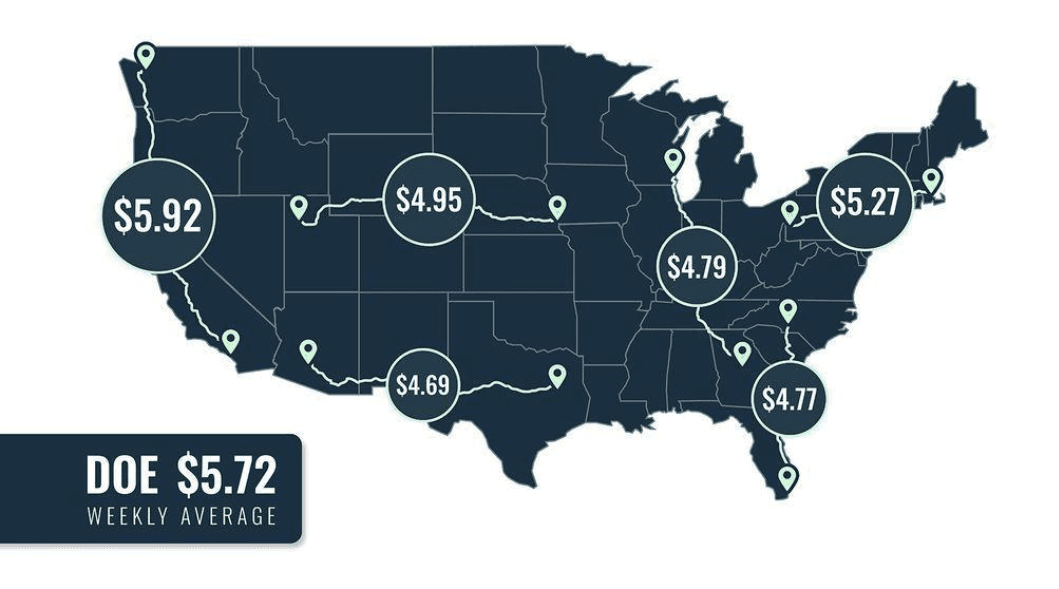How Manufacturers Can Fight Inflation by Cutting Freight Costs

Trending
Top Posts
7 min read
November 11, 2025

Share:
Table of contents
Browse the table of contents to jump straight to the part you’re looking for
Fuel price volatility, mounting pressure to reduce emissions, and a growing demand for transparency in transportation spend have made effective fuel management a top priority for shippers. Traditional fuel surcharge programs, often based on national or regional averages, are no longer sufficient. They create inaccuracies that can erode budgets and strain carrier relationships. A modern fuel management system is the solution, providing the data-driven accuracy required to navigate today’s complex freight landscape.
This guide provides a comprehensive overview of what a modern fuel management system entails. We will explore its core components, outline a step-by-step process for evaluation and implementation, and demonstrate how a market-based approach delivers superior results compared to traditional models.
In transportation, a fuel management system is a comprehensive solution that combines software, data, and market expertise to control and optimize fuel-related costs, efficiencies, and sources. Unlike fuel surcharge schedules, a sophisticated system provides deep visibility into the true cost of fuel for every lane in your network. It replaces average reimbursement models with data-backed accuracy.
The core components of a leading fuel management system include:
This is the cornerstone of a modern system. Instead of relying on weekly DOE averages, a market-based program like Fuel Recovery calculates reimbursements using the price, time, tax, and origin and destination pair for each movement. This four-dimensional model ensures that payments accurately reflect the actual fuel costs a carrier incurs at a shipment-by-shipment level.
A user-friendly fuel management system seamlessly integrates with your existing processes. This seamless data flow enables you to create a single source of truth, providing detailed reporting and analytics to identify opportunities for optimization.
As sustainability becomes a critical business imperative, the ability to accurately track transportation emissions is essential. Modern fuel management systems will track your fuel consumption to calculate an accurate scope 1 and 3 transportation emissions baseline. This allows you to understand your network’s carbon footprint, identify emission hotspots on a lane-level, and make data-driven decisions to support your corporate sustainability goals.
Fuel price volatility poses a significant risk to transportation budgets. An advanced fuel management system can integrate hedging solutions, like T-Fuel, to lock in to manage this volatility, creating greater budget certainty and financial predictability.
Beyond fair fuel reimbursement, a holistic fuel management system considers carrier truck efficiency across your network. By analyzing third-party industry data sources as well as $32 billion in transportation spend, a fuel management system will automatically calculate how much fuel your carriers are consuming to reimburse carriers accurately.
The shift toward alternative energy, such as renewable natural gas, electric, and renewable diesel, has introduced new complexities for transportation teams to fairly and accurately manage their fuel programs. This transition requires thoughtful consideration of energy type and cost discrepancies from diesel fuel. A comprehensive fuel management program is designed to address these differences, ensuring accurate reimbursement.
Adopting a new fuel management system is a strategic decision that requires careful planning and execution. Following a structured approach ensures a smooth transition and maximizes the value of your investment.
When assessing fuel management systems, look for a provider that offers:
A successful implementation hinges on a clear change management plan and stakeholder buy-in. Effective change management is crucial to communicate the benefits of moving away from traditional fuel surcharge schedules and to ensure all stakeholders understand how the new, more accurate system works.
Transportation leaders often face challenges like fragmented data, internal resistance to change, and limited resources. The key to overcoming these hurdles is a partnership. A dedicated provider will work with you to clean and centralize data, demonstrate the financial and operational benefits to secure buy-in, and manage the transition for your carrier network to ensure a successful launch, all while saving you money.
Not all fuel management systems are created equal. The distinction between a market-based program and a traditional index-based one is significant.
Traditional surcharge programs use weekly national or PADD-level DOE index prices to calculate reimbursements. This method fails to account for the significant price variations that occur daily and between different locations. Breakthrough’s fuel management system calculates fuel reimbursements based on the average price of fuel along each lane. This reflects the true cost exposure for carriers, creating a fair and accurate transaction every time.

Breakthrough’s four-dimensional pricing model is grounded in your actual data—not average indices. This precision is what makes the fuel management system superior. By accounting for all the variables that influence fuel cost, it removes the distortions inherent in index-based programs. This level of accuracy improves fairness, strengthens carrier relationships, and often drives significant cost savings.
The impact of this accuracy is clear. For example, Altium Packaging saved 15.7% on its fuel spend in its first year using Fuel Recovery. By moving to a market-based fuel management system, the company eliminated overpayments and gained precise insights into its transportation costs, demonstrating the bottom-line impact of data-driven fuel management.
Adopting Fuel Recovery is one of the most impactful decisions a transportation leader can make to control costs, build stronger carrier partnerships, and advance sustainability goals. By replacing outdated averages with insight-driven accuracy, you can unlock new levels of efficiency and savings in your transportation network.
What is a fuel management system and how does it work?
A fuel management system is a solution used by shippers to control transportation fuel costs. It works by collecting shipment-level data and applying real-time fuel prices to calculate accurate reimbursements, replacing national averages and providing deep visibility into cost and consumption.
How can shippers reduce fuel costs with a fuel management system?
A fuel management system reduces costs by ensuring you pay a fair and accurate price for the fuel consumed in your network. It eliminates the overpayments common with traditional surcharge programs and provides transparency into actual prices, empowering you to make more cost-effective network decisions.
What’s the difference between market-based and index-based fuel reimbursement?
Index-based fuel reimbursement uses a once-weekly, single national price based on a sample of less than 10% of all national fuel stations. However, we know most carriers procure fuel at wholesale pricing. Market-based fuel reimbursement, the approach used by industry-leading shippers, calculates a fair and accurate price that considers the time, price, tax, and geography of the freight movement.
Can a fuel management system help with emissions tracking and reporting?
Yes! A modern fuel management system uses fuel consumption data to provide a precise transportation emissions baseline. This enables shippers to accurately track their transportation carbon footprint, report on scope 1 and 3 transportation emissions, and identify strategies for reduction.
Fuel Recovery
Calculate how much you can save in costs and emissions with a market-based program.


6 min read
November 10, 2025
Explore how the proposed Union Pacific–Norfolk Southern merger could reshape rail in the U.S. Learn impacts on competition, pricing, and service.
Read more
5 min read
October 28, 2025
Two major oil refineries in California are closing, removing 17.5% of the state's capacity. Learn how this will impact fuel premiums and your supply chain.
Read more
9 min read
October 23, 2025
Discover how fuel management software helps shippers cut costs, boost efficiency, and meet sustainability goals in transportation.
Read more